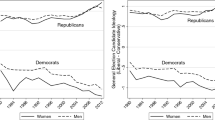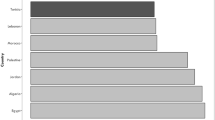Abstract
In 2009, women are still dramatically underrepresented in elected office in the United States. Though the reasons for this are complex, public attitudes toward this situation are no doubt of importance. While a number of scholars have demonstrated that women candidates do not suffer at the ballot box because of their sex, we should not assume that this means that voter attitudes about gender are irrelevant to politics. Indeed, individual attitudes towards women’s representation in government and a desire for greater descriptive representation of women may shape attitudes and behaviors in situations when people are faced with a woman candidate. This project provides a more complete understanding of the determinants of the public’s desire (or lack thereof) to see more women in elective office and support them in different circumstances. The primary mechanism proposed to explain these attitudes is gender stereotypes. Gender stereotypes about the abilities and traits of political women and men are clear and well documented and could easily serve to shape an individual’s evaluations about the appropriate level and place for women in office. Drawing on an original survey of 1039 U.S. adults, and evaluating both issue and trait stereotypes, I demonstrate the ways in which sex stereotypes do and do not influence public willingness to support women in various electoral situations.




Similar content being viewed by others
Notes
While this study does not directly examine people’s evaluations of Pelosi or Clinton, I do acknowledge that their presence in the political world may have influenced how people think about the appropriate representation of women in government. This notion that observing women in office can influence public attitudes is the basis for the work on the impact of women’s symbolic mobilization (Atkeson 2003; Hansen 1997; Koch 1997).
The correlations between the four variables measuring the gendered political stereotypes are as follows:
Female policy
Male policy
Female traits
Male traits
Female policy
–
.245*
.398*
.134*
Male policy
.245*
–
.232*
.338*
Female traits
.398*
.232*
–
−.038
Male traits
.134*
.338*
-.038
–
The correlations between the four dependent variables are as follows:
Baseline preference
Women president Republican
Women president Democrat
Parity
Baseline Preference
–
−.029
.431*
.384*
Republican Women president
−.029
–
.094*
.045
Democrat Women president
.431*
.094*
–
.360*
Gender parity
.384*
.045
.360*
–
Recall that the female policies are education and health care, while the male policies are terrorism and the economy. Female traits are compassionate and consensus building, while male traits are ambitious and aggressive.
I also conducted a seemingly unrelated estimates (SUE) analysis. The results of that analysis were completely consistent with the results reported in Table 4.
References
Alexander, D., & Andersen, K. (1993). Gender as a factor in the attribution of leadership traits. Political Research Quarterly, 46, 527–545.
Ashmore, R., & Del Boca, F. (1979). Sex stereotypes and implicit personality theory: Toward a cognitive-social psychological conceptualization. Sex Roles, 5, 219–248. doi:10.1007/BF00287932.
Atkeson, L. R. (2003). Not All cues are created equal: The conditional impact of female candidates on political engagement. The Journal of Politics, 65, 1040–1061. doi:10.1111/1468-2508.t01-1-00124.
Brians, C. (2005). Women for women: Gender and party bias in voting for female candidates. American Politics Research, 33, 357–375. doi:10.1177/1532673X04269415.
Burrell, B. (1994). A woman’s place is in the house: Campaigning for congress in the feminist era. Ann Arbor: University of Michigan Press.
Burrell, B. (2008). Political parties, fund-raising, and sex. In B. Reingold (Ed.), Legislative women: Getting elected, getting ahead. Boulder, CO: Lynne Rienner.
Center for American Women, Politics. (2009). Women in elective office 2009. Center for American Women and Politics, Eagleton Institute of Politics, Rutgers University.
Deaux, K., & Lewis, L. (1984). Structure of gender stereotypes: Interrelationships among components and gender label. Journal of Personality and Social Psychology, 46, 991–1004.
Dolan, K. (2004). Voting for women: How the public evaluates women candidates. Boulder, CO: Westview Press.
Fox, R., & Smith, E. (1998). The role of candidate sex in voter decision making. Political Psychology, 19, 405–419.
Fulton, S., Maestas, C., Maisel, L. S., & Stone, W. (2006). The sense of a woman: Gender, ambition, and the decision to run for congress. Political Research Quarterly, 59, 235–248.
Hansen, S. (1997). Talking about politics: Gender and contextual effects on political proselytizing. Journal of Politics, 59, 73–103.
Huddy, L., & Terkildsen, N. (1993a). Gender stereotypes and the perception of male and female candidates. American Journal of Political Science, 37, 119–147.
Huddy, L., & Terkildsen, N. (1993b). The consequences of gender stereotypes for women candidates at different levels and types of office. Political Research Quarterly, 46, 503–525.
Kahn, K. (1996). The political consequences of being a woman: How stereotypes influence the conduct and consequences of political campaigns. New York: Columbia University Press.
King, D., & Matland, R. (2003). Sex and the grand old party: An experimental investigation of the effect of candidate sex on support for a Republican candidate. American Politics Research, 31, 595–612.
Koch, J. (1997). Candidate gender and women’s psychological engagement in politics. American Politics Quarterly, 25, 118–133.
Koch, J. (1999). Candidate gender and assessments of senate candidates. Social Science Quarterly, 80, 84–96.
Koch, J. (2002). Gender stereotypes and citizens’ impression of house candidates ideological orientations. American Journal of Political Science, 46, 453–462.
Lawless, J. (2004). Women, war, and winning elections: Gender stereotyping in the post-September 11th era. Political Research Quarterly, 57, 479–490.
Lawless, J., & Fox, R. (2005). It takes a candidate: Why women don’t run for office. New York: Cambridge University Press.
Lawless, J., & Pearson, K. (2008). The primary reason for women’s underrepresentation? Reevaluating the conventional wisdom. Journal of Politics, 70, 67–82.
Leeper, M. (1991). The impact of prejudice on female candidates: An experimental look at voter inference. American Politics Quarterly, 19, 248–261.
Palmer, B., & Simon, D. (2006). Breaking the political glass ceiling: Women and congressional elections. New York: Routledge.
Rosenthal, C. S. (1995). The role of gender in descriptive representation. Political Research Quarterly, 48, 599–611.
Rossenwasser, S., & Seale, J. (1988). Attitudes toward a hypothetical male or female presidential candidate—a research note. Political Psychology, 9, 591–598.
Sanbonmatsu, K. (2002). Gender stereotypes and vote choice. American Journal of Political Science, 46, 20–34.
Sanbonmatsu, K. (2006). Where women run: Gender and party in the American states. Ann Arbor: University of Michigan Press.
Sanbonmatsu, K. & Dolan, K. (2009). Do gender stereotypes transcend party? Political Research Quarterly, 62.
Sapiro, V. (1981/1982). If U.S. Senator Baker were a woman: An experimental study of candidate images. Political Psychology, 7, 61–83.
Shapiro, R., & Mahajan, H. (1986). Gender differences in policy preferences: A summary of trends from the 1960s to the 1980s. Public Opinion Quarterly, 50, 42–61.
Simmons, W. (2001, January). A majority of Americans say more women in political office would be positive for the country. The Gallup Poll Monthly, 6–9.
Acknowledgments
The author wishes to thank Jennifer Lawless, Tom Holbrook, and the reviewers for their comments and suggestions.
Author information
Authors and Affiliations
Corresponding author
Appendices
Appendix 1—Demographics of Survey Respondents
See Table 5.
Appendix 2
Dependent Variables
-
1.
If two equally qualified candidates were running for office, one a man and the other a woman, do you think you would be more likely to vote for the man or the woman?
Man/Woman
-
2.
If the Republican Party nominated a woman for President, would you vote for her if she were qualified for the job?
Yes/No
-
3.
If the Democratic Party nominated a woman for President, would you vote for her if she were qualified for the job?
Yes/No
-
4.
In your opinion, in the best government the U.S. could have, what percent, [from 0 to 100], of elected officials would be men and what percentage would be women?
Independent Variables
-
1.
In general, do you think men or women in elected office are better at (improving our schools, dealing with terrorism, handling health care issues, handling the economy)?
Man/Woman/No Difference
-
2.
When you think about political candidates and officeholders, do you think men or women would tend to be more (assertive, compassionate, consensus builder, ambitious)?
Man/Woman/No Difference
-
3.
Respondent sex, education, party identification, race, age, income, and state of residence
Rights and permissions
About this article
Cite this article
Dolan, K. The Impact of Gender Stereotyped Evaluations on Support for Women Candidates. Polit Behav 32, 69–88 (2010). https://doi.org/10.1007/s11109-009-9090-4
Received:
Accepted:
Published:
Issue Date:
DOI: https://doi.org/10.1007/s11109-009-9090-4




